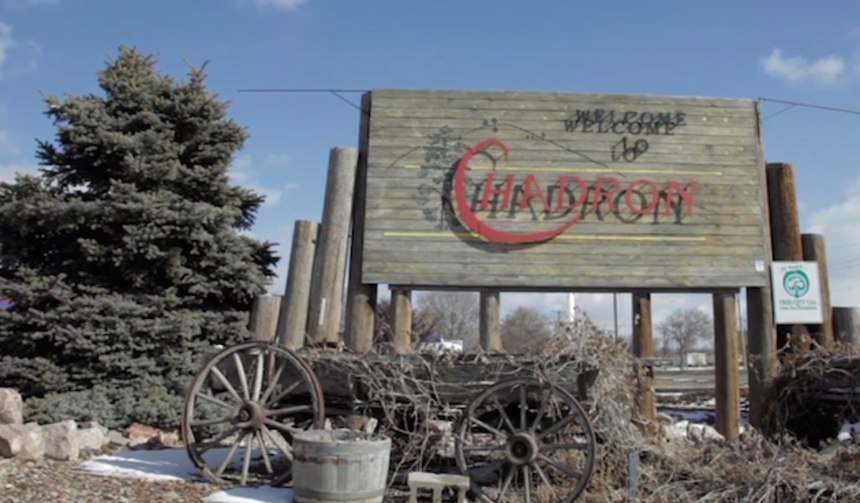Hot Docs 2014 Review: LOVE AND TERROR ON THE HOWLING PLAINS OF NOWHERE

The town, described as 'politely hanging on' after peaking somewhere in the 19th century, is host to the State College and was the hometown of NFL wide receiver Don Beebe, but is now quite remarkable for its motley collection of characters unearthed and endeared by author Poe Ballantine (himself one of those characters) in his memoir-slash-true-crime novel, "Love and Terror on the Howling Plains of Nowhere: A Memoir."
It has been adapted, wrangled, and condensed into documentary form by Dave Janetta in the same tattered, rascally spirit as the book - equal parts pragmatism and poetry. Love and Terror on the Howling Plains of Nowhere is morbid, hilarious and whipsmart film-making that belies its strained budget and open-ended narrative. It will never look as good as The Imposter or offer the closure of The Thin Blue Line, but its humour is mighty. The Chadron Record's 'Police Beat' newspaper column which features heavily here (more on that in a minute) alone is a treasure of treasures.
In deep dark winter of 2006, the college's resident PhD theoretical mathematics professor, Steven Haataja, withdrew $100 from the local cash machine and bought a large bag of charcoal from the Safeway before trundling off onto the wilderness in sub-zero (Fahrenheit) temperatures. The townsfolk and the local police are baffled that the introverted professor, who appeared to be settling into the community just fine, left before the end of the semester without offering any closure to his occupation, family, or colleagues.
Chadron has always been a town of transience, a way-station for drifters (or footballers) to Denver or Omaha or any other American city, so someone up and leaving for greener pastures was a common enough event and an eccentric exit from a nebbish math professor was chalked up as just that. Already a source of gossip and amateur sleuthing, when Haataja's corpse was found in the spring by a rancher on his property a few miles from campus, in copse of trees bound with electrical cords and burned right down to the bones, it becomes the towns biggest mystery.
This is the shocking event that coagulates the towns academics and eccentrics in the Olde Main Street Inn, and further alienates the libertarian locals from their less than competent police force, who once had two cruisers head-on collide on a deserted street with each other while responding to a domestic dispute. The local newspaper chronicles the strange and frequent calls from residents by printing the call-transcripts into a column, the aforementioned Police Beat (which Ballantine describes as a 'textual anti-depressant': "Caller from the 400 block of Ann St. advised that his sister had come into his home and was pretending to be his wife." and "Caller from the 600 block of West Second St. advised that her 11-year-old son was misbehaving, had not gone where he was supposed to after school and was now being very disruptive. Caller advised he had thrown spaghetti outside.")
All of this is dovetailed with the life and times of 'modern-beat' author Ballantine, who acts a tour-guide, philosopher and raconteur. Chadron is his adopted home of many years, where he finally settled with his Mexican-dentist wife and autistic son (who is effervescent and charming on camera) after a life of wandering as a short order cook and writer. Graying and plain in his mid 50s was friend and neighbor with Haataja, and drolly opines to the camera about his town and circumstance without losing a wisp of dignity in the process.
Between the talking head segments (all great), and various home-video of some of the regions apocalyptic weather, Janetta peppers the proceedings with film clips from Billy Wilder's Ace in the Hole to Woody Allen's Manhattan (and a telling interview of Orson Welles by Dick Cavett) to try to understand a narrative without closure; certainly any film adaptation Cormac McCarthy would slot nicely in there if it were present.
To confront such a horrible event with humour and self-deprecating grace is a service. There is empathy in the procedural process towards edge of the unknowable which reminds me of another shoe-string, but excellent doc, Resurrect Dead: The Mystery of the Toynbee Tiles. Poe, who shares a name with the worlds first true-crime writing eccentric, is brilliant as the gateway to the weirdness, pettiness, and yes, empathy, of Chadron, Nebraska.
On the strength of the film, I immediately purchased and read the book, fast enough that I turned the last (electronic) page before the receipt for the purchase arrived in my email. I'll be following The Record's Police Beat for some time to come.

Do you feel this content is inappropriate or infringes upon your rights? Click here to report it, or see our DMCA policy.





